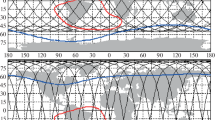Abstract
The influence of spatial orientation of the International Space Station (ISS) on the dose rate recorded during passages of the station through the South-Atlantic anomaly (SAA) zone is considered. The dose rates detected by dosimeters of the radiation control system of the ISS are compared with results of calculation-based estimates. It is shown that when crossing the SAA region in close trajectories, but with different spatial orientation of the station, the dose rate near cabins of the ISS Service Module can differ by more than a factor of two.
Similar content being viewed by others
References
Miroshnichenko, L.I. and Petrov, V.M., Dinamika radiatsionnykh uslovii v kosmose (Dynamics of Radiation Environment in Space), Moscow: Energoatomizdat, 1985.
Benghin, V.V., Petrov, V.M., Ivanov, Yu.V., et al., Space Radiation Quality Factor Investigations with Nausicaa Device on Board the Mir Space Station, Adv. Space Res., 1996, vol. 18, no. 12, p. 167.
Lishnevskii, A.E., Panasyuk, M.I., Benghin, V.V., et al., Variations of Radiation Environment onboard the ISS in the Year2008, Kosm. Issled., 2010, vol. 48, no. 3, pp. 212–217. [Cosmic Research, pp. 206–210].
Sakaguchi, T., Doke, T., Hasebe, N., et al., Measurement of the Directional Distribution of Incident Particles in the Shuttle-Mir Mission Orbit, J. Geophys. Res., 1999, vol. 104, no. A10, pp. 22793–22799.
Benghin, V.V., Petrov, V.M., and Shurshakov, V.A., Accounting for Effects of West-East Asymmetry of Proton Fluxes in the South Atlantic Magnetic Anomaly Region, Kosm. Issled., 1993, vol. 31, no. 4, p. 82.
Chernykh, I.V., Semkova, I., Petrov, V.M., et al., Influence of Orientation of the International Space Station on the Dose Rate Recorded by Detectors of the Lyulin-5 Instrument, Intern. Conf. “Fundamental Space Research: New Developments in Geospace Monitoring of the Black Sea Region and Prospects of Their Realization,” Slanchev Bryag, Bulgaria, September 22–27, 2008, pp. 141–146.
Chernykh, I.V., Petrov, V.M., and Shurshakov, V.A., ISS Attitude Influence on the Dose Rate Measured with Detectors of Liulin-5 Instrument, 13th Workshop on Radiation Monitoring for the International Space Station, 8–10 Sept. 2008, Krakow, Poland.
Lyagushin, V.I., Volkov, A.N., Aleksandrin, A.P., et al., Preliminary Results of Measuring Absorbed Dose Rates with Radiation Control System of Russian Segment of the International Space Station, Vopr. At. Nauki Tekh., Ser. Fizika Radiats. Vozd. na Radioelektr. Apparat., 2002, issue 4, pp. 22–25.
Drobyshev, S.G. and Benghin, V.V., Accounting for the Influence of Space Orientation of the International Space Station on Dose Rate during Passage of the South Atlantic Anomaly, Aviakosm. Ecolog. Med., 2009, vol. 43, no. 5, pp. 58–63.
Kuznetsov, N.V. and Nikolaeva, N.I., An Empirical Model of Pitch-Angle Distributions of Trapped Protons on the Inner Boundary of the Earth’s Radiation Belt, Kosm. Issled., 2011, vol. 50.
Mitrikas, V.G., Protectability Model for Manned Compartments of the Service Module of the International Space Station for Estimation of Radiation Safety, Aviakosm. Ecolog. Med., 2004, vol. 38, no. 3, pp. 41–47.
Model’ kosmosa: Nauchno-informatsionnoe izdanie (Model of the Cosmos: Information and Reference Book), Panasyuk, M.I. and Novikov, L.S., Eds., Moscow: KDU, 2007, vol. 1, pp. 642–667.
Haffner, J.W., Yadernoe izluchenie i zashchita v kosmose (Nuclear Radiation and Protection in Space), Moscow: Atomizdat, 1971.
Metodicheskie ukazaniya. Metodika rascheta pogloshchennoi i ekvivalentnoi doz ot protonov kosmicheskikh luchei za zashchitoi. RD 50-25645.208-86 (Methodical Guide: Methods of Calculation of Absorbed and Equivalent Dose Rates from Cosmic Ray Protons behind a Shield. RD 50-25645.208-86), Moscow: Izdvo Standartov, 1986.
Hess, W.N., The Radiation Belt and Magnetosphere, NY, USA: Blaisdell Publ. Co., 1968. Translated under the title Radiatsionnyi poyas i magnitosfera, Moscow: Atomizdat, 1972.
Roederer, J., Dynamics of Geomagnetically Trapped Radiation, Heidelberg: Springer, 1970. Translated under the title Dinamika radiatsii, zakhvachennoi geomagnitnym polem, Moscow: Mir, 1972.
Ponomarev, A., Nounu, H., and Hussein, H., NASA-Developed ProE-Based Tool for the Ray-Tracing of Spacecraft Geometry to Determine Radiation Doses and Particle Fluxes in Habitable Areas of Spacecraft and in the Human Body, NASA/TP-2007-214770.
Author information
Authors and Affiliations
Corresponding author
Additional information
Original Russian Text © S.G. Drobyshev, V.V. Benghin, 2011, published in Kosmicheskie Issledovaniya, 2011, Vol. 49, No. 5, pp. 411–418.
Rights and permissions
About this article
Cite this article
Drobyshev, S.G., Benghin, V.V. Estimation of the effect of orientation of International Space Station on the dose rate in Station’s Service Module when passing through the South-Atlantic anomaly region. Cosmic Res 49, 399–406 (2011). https://doi.org/10.1134/S0010952511050054
Received:
Published:
Issue Date:
DOI: https://doi.org/10.1134/S0010952511050054




